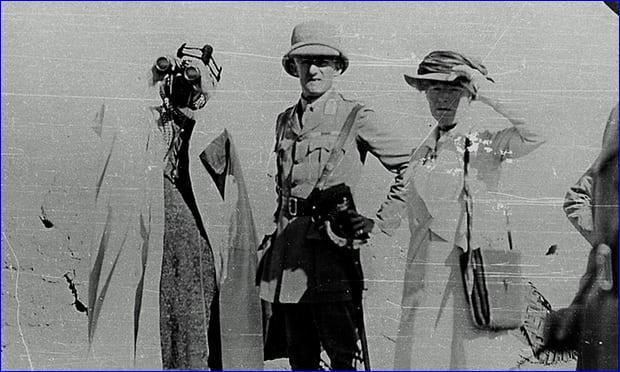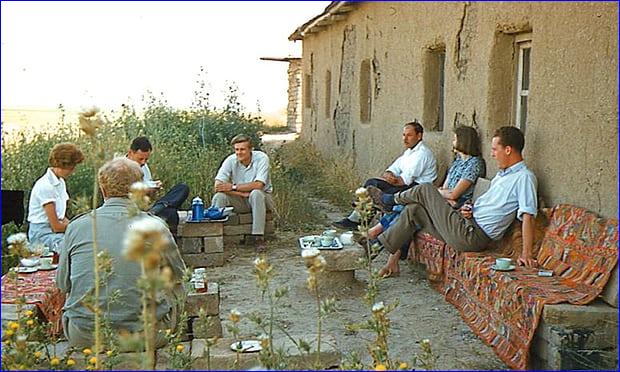


 Gertrude Bell Archive/Newcastle University)
Gertrude Bell Archive/Newcastle University)
The British School of Archaeology in Iraq (BSAI) was Gertrude Bell's idea and she was the reason for this gathering of the great and good. Famous as a traveller and writer, and deeply tangled in the politics of mandated Iraq and the wider Middle East, Bell's primary passion throughout her life was archaeology. When she died in 1926 she left £6,000 with the trustees of the British Museum to be used to found the BSAI.
The appeal for funds in 1929 had a target of a further £14,000 to make the school viable, but the timing was bad; just a month earlier the Wall Street Crash had triggered the Great Depression and by the winter of 1931 the fund stood at just £9,359. Nevertheless, just as the British Mandate in Iraq was coming to an end, the BSAI was launched, although on a smaller scale than had been originally intended.
The school's stated goals were focused on enabling British archaeologists and students to work in Iraq or on Iraqi material, through directly funding excavations and by providing scholarships and travel grants. Short of the funds it needed to operate in Iraq, the BSAI struggled through the 1930s until work was stopped by the war. Without its own fieldwork, the school helped Iraqi archaeologists to publish their work through the BSAI's journal 'Iraq'.
The post-war years smiled on the British School of Archaeology in Iraq. In 1946 the school received its first government funding and in 1947 parliament voted it £4,000, allowing the BSAI to finally buy a house in Baghdad and set up shop properly. Sir Max Mallowan was appointed as the first director and immediately took up residence, along with a secretary, six students and Agatha Christie, Sir Max's more famous wife. Christie is still noted in archaeology circles for having written the archaeological crime novel Murder in Mesopotamia. Mallowan and the British School spent the next decade excavating the spectacular ancient Assyrian capital at Nimrud, which was partly destroyed by ISIS militants in 2015.

 Ann Searight)
Ann Searight)
The BSAI kept busy in the 1960s with new excavations at Tell al-Rimah and Tell Taya. The school moved to bigger and better Baghdad premises and by the early 1970s it was hosting around 70 students and researchers per year. As well as running a packed excavation programme, the BSAI was a hub for an eclectic range of foreign visitors and diplomats, and a vibrant point of contact between international and Iraqi archaeologists. The school's library was probably the best collection of books on Mesopotamian archaeology in the Middle East, in addition to having an excellent selection of crime fiction. Baghdad in the 1970s and 80s was a thriving, modern and dynamic city and life at the BSAI was rich and exciting.
Trouble, however, was on the horizon; in 1968 the Ba'ath party had seized power and life was becoming more and more difficult for Iraqis and foreigners alike. In 1973 a new law required all foreign schools to re-register; the British School's application, along with most of the others, was refused and it was officially closed down. Nicholas Postgate, the director at that time, convinced a sympathetic Iraqi Department of Antiquities to allow work to continue under a new name. Relocated to new premises, the BSAI continued under the alias of The British Archaeological Expedition in Iraq.

 P Dorrell/Ann Searight)
P Dorrell/Ann Searight)
In 1976 Agatha Christie died and her passing was marked by the BSAI in London with solemn tributes. Her ghost still lingered at the Baghdad HQ, partly in the form of the toilet chair she had had constructed so that she didn't have to squat over site latrines. Unfortunately, this throne, complete with specially imported toilet seat, is lost to history as it was inadvertently burnt by an intoxicated member of the excavation team on Guy Fawkes night sometime in the late 1970s.
In 1977, a new intensive phase of fieldwork began for the school, initiated by a programme of major dam construction in northern Iraq. The Department of Antiquities invited foreign teams to conduct salvage excavations in the vast areas which were to be flooded and the BSAI swung into action. Compared to current projects, fieldwork was on an epic scale, with teams maintained in the field for six to nine months of the year, employing large numbers of local workmen. The work was hard and sometimes unpredictable; on one occasion the Iraqi authorities decided to test the Eski Mosul Dam without informing anyone first, meaning that villagers and archaeologists alike were forced to save what they could and flee a wave of rapidly rising water.
The Iran-Iraq war introduced new dangers and challenges through the 1980s. Food supplies were erratic and the BSAI staff had to queue with everyone else for essentials like bread and eggs. Without diplomatic contacts or company fixers life at the school was tough; there was no running water and frequent power cuts. The increasingly shabby school house became home to collapsing furniture, spiders, termites and fleas. From the roof, staff could watch the fall of Iranian Scud missiles into the Baghdad suburbs. Life was ever more restrictive; it was dangerous to carry a map or a camera, all letters were opened and read by the Iraqi censors, and the government minister in the house next door was killed after falling out of favour. Iraqi archaeologists no longer visited, although BSAI staff still passed on books and journals when they could.
The eruption of the First Gulf War in 1990 brought an end to international archaeology in Iraq. The British School locked its doors in Baghdad, hoping to return soon, and shifted fieldwork to Syria and Bahrain. This began a period in which the purpose of the BSAI fundamentally changed. Alarmed by the first flush of looting which swept sanction-hit Iraq in the mid-1990s, the BSAI found itself becoming increasingly involved in what would become an ongoing heritage crisis. Instead of funding British students to go to Iraq, the BSAI started to fund Iraqis to come to study in Britain. The school sent academic books and periodicals to Iraqi universities, which were cut off from international scholarship, and funded conservation work at the Iraq Museum. After the US invasion in 2003, the BSAI set up a major fundraising effort to help Iraqi heritage and two new aims were added to the school's constitution; to assist Iraqi colleagues and to inform and engage the public about what was happening to Iraq and its cultural heritage.
At the height of the post-Saddam looting, disaster struck for the BSAI. Since its first parliamentary grant in 1946, the school had become increasingly dependent on government money rather than its endowments and subscribers. By the early 2000s the school had long relied on a large annual block grant from the British Academy, but the model of giving large sums to schools and societies, rather than targeting specific projects, was falling out of favour, as to some extent were institutions like the BSAI, which were considered too narrow and to some could appear antiquated, with a lingering odour of colonialism. British Academy funding was reduced through the late 1990s, halved in 2007 and withdrawn entirely in 2009. Frustration at the BSAI was enormous as they watched the same UK government which had done little to prevent the looting and ransacking of Iraqi sites and museums after the war pull the plug on one of the few UK organisations which was doing anything about it. The British School of Archaeology in Iraq faced extinction after 75 years.
In the event, the British School didn't die but managed to reinvent itself. In 2007 it was re-founded as the British Institute for the Study of Iraq (BISI); no longer restricted to archaeology and history, no longer focused on facilitating British archaeologists, but on promoting Iraqi heritage and culture and on assisting Iraqi heritage specialists through partnerships, collaborations and scholarships. With considerable difficulty the financial crisis was at least partially overcome through a combination of fundraising, realising assets, and substantial support from the British Museum. Allowed to retain its office space at the British Academy, the BISI could continue to function, although on a reduced level.
Ten years on, the work of the British Institute for the Study of Iraq is now well established. Forty Iraqi researchers have benefitted from visiting scholarships to the UK and BISI organises frequent events to promote Iraqi culture. BISI has played an important part in the return of international archaeologists to fieldwork in Iraq after a generational hiatus. It has also had a major role in the establishment of the new Basra Museum, opened just a few months ago, very much in the spirit of Gertrude Bell, who herself founded the Iraq Museum in Baghdad. None of this, however, would have been possible without the network of contacts and the good will generated through the BSAI years. Although BISI no longer engages in the grand-scale excavation projects of its past, the current approach of BISI, focused more on helping people and their heritage and less on putting large holes in archaeological sites, is what Iraqi heritage needs in the short and medium term. Gertrude Bell's British School of Archaeology in Iraq may have gone through a lot since its inception in 1926, but it's still very much alive and perhaps more relevant than ever.

or register to post a comment.